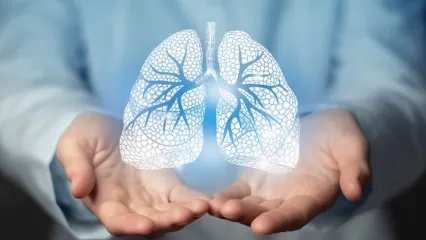Alo Yeditepe
Alo Yeditepe
Lung Cancer Screening Age
In the New Guidelines which American Cancer Society published, wrote that worked Lung Cancer Screening Age down
The American Cancer Society lowered the lung cancer screening age in its new updated guide. Chest Diseases Specialist Dr. Lecturer, Seha AKDUMAN said that one of the most important steps in reducing the loss of life in lung cancer is early diagnosis. Lecturer. Seha Akduman stated that in line with this decision, the early screening diagnosis age was reduced from 55 to 50 and the smoking years were reduced from 30 pack /year to 20 pack/ year.
Underlining that even if there are developments such as immunotherapy and personalized smart drugs in lung cancer, the stage of the disease is one of the most critical indicators of treatment success in survival. Dr. Lecturer Seha Akduman said, “Today, we know that the most effective method for early diagnosis is low-dose lung tomography. "Studies conducted as a result of this direct relationship between treatment success and early diagnosis have found a significant rate of new lung cancer detection using low-dose tomography in smokers between the ages of 50 and 80 who smoke 20 pack/year," she said.
Our specialist explained the difference between Low Dose Thorax Tomography and Standard Tomography as follows: “The radiation received with Standard Thorax CT is reduced to approximately one-fifth the dose and the lung is examined. "When detecting a mass or nodule, radiation exposure, which we know to be carcinogenic, is reduced."
Life expectancy of patient with lung cancer that early diagnosed is extended
Lung cancer continues to remain in the first place among cancer-related deaths in men and women. However, Yeditepe University Koşuyolu Hospital Chest Diseases Specialist said that the only way to extend life in lung cancer is early diagnosis and that the only way to ensure disease-free survival is surgery, whereas only stage 1 and stage 2 cases can be operated on. Our expert stated that the most effective method today for early diagnosis is lung imaging with low-dose tomography with reduced radiation dose, and pointed out the importance of the decision taken by the American Cancer Society. In the 2021 guide of the Chest Diseases Specialist, who stated that the most effective method today is to scan risky groups with reduced radiation dose thorax tomography to make early diagnosis, the age of lung imaging early diagnosis was 55 and 30 pack years of smoking, but now this screening age has been reduced to 50 in 2023. "Instead of 30 pack/year, patients with a 20-pack/year smoking history were included in the screening age group."
The Situation of Lung Cancer in Our Country
“In Turkey, in patients who smoked heavily and had high risk factors, tomography was performed for reasons such as bloody sputum and prolonged cough, but the disease was usually detected as advanced in these symptomatic individuals,” our expert said and continued: “On the other hand, due to fear of radiation and lack of data in the screening criteria Both patients and physicians stayed away from tomography. Screening criteria have become clear in the last 5 years, and with low-dose thorax CT, treatment success increases with early diagnosis in individuals without complaints. "With Covid, we saw that the diagnosis was made very early with the tomography scans, and the chance of cure in lung cancers with early diagnosis has increased significantly."
The Most Important Way to Increase Survival in Lung Cancer is Early Diagnosis
Chest Diseases Specialist Dr. AKDUMAN said that while the five-year survival rate in stages 1 and 2 of lung cancer increases to 50-60 percent, this rate decreases to 10 percent in more advanced stages. There is a serious relationship between them. Therefore, the most important way to increase survival is to make an early diagnosis today.”
Our specialist said that the next control tomography is determined by the existing lung findings and said: “If there is no risky situation with the screening tests, then the next scan will be one year later. However, if there is a nodule or other suspicious images, follow-up is required. Everyone's next follow-up CT scan is determined by the lung findings. "If there is a risk factor in the family, if they work in a profession that is risky for lung cancer, if they are exposed to dust, smoke, chemicals, or if they smoke and continue to be passively exposed, a screening test is also recommended in these groups."
Depending on the location of the tumor, lung cancer may progress without any symptoms.
Reminding that lung cancer can progress without any symptoms depending on the location of the tumor, Yeditepe University Hospitals Chest Diseases Specialist explained that regular follow-ups are vital in early diagnosis. Our expert continued her words as follows:
“Unless the tumor settles in the bronchi, nerve cells or lung membrane, it may not cause any symptoms even if it spreads to the entire lung. Cancer progresses insidiously, without the patient being aware of anything. For this reason, approximately 60 percent of patients reach us at an advanced stage. Therefore, the real problem is detecting it at an early stage. However, what patients need to know is this: "At the point reached today in lung cancer treatment, even disease-free survival is possible with early diagnosis."
About
Faculty and Year of Graduation:
Gazi University Faculty of Medicine, 2007
”
See Also
- How to Cleanse Your Lungs?
- Is Breathing Air Dangerous in Fires?
- What is Electronic Cigarette Disease (EVALI)? EVALI Symptoms and Treatment
- What is COPD? Symptoms and Treatment of COPD
- Long Journeys Increase the Risk of Embolism!
- What Asthma and COPD Patients Should Pay Attention to When Using Air Conditioning!
- What is Allergy? What are the Symptoms of Allergy?
- What is Desert Dust? Harms of Desert Dust
- What is Good for Cough? How to Cure Cough?
- Lung Cancer Symptoms and Treatment
- 10 Ways to Have a Sound Sleep in the Heat
- What Should Asthma Patients Be Cautious About?
- Does Poor Quality Sleep Increase The Risk of Asthma?
- What Causes Insomnia, Diagnosis and Treatment
- 9 Common Misconceptions About COPD
- Causes, Symptoms, and Treatment of Asthma
- Allergy and Asthma During Pregnancy
- It Is Aimed to Eliminate Tuberculosis Worldwide By 2030
- Lung Patients Should Not Stop Their Medications
- 4 Significant Preliminary Symptoms of Lung Cancer
- How Does Acid Rain Affect Human Health?
- The Slowing Traffic in Istanbul Increases the Risk of Cancer!
- The American Cancer Society Has Announced; The Age of Screening For Lung Cancer Has Decreased
- Hidden Lung Cancer Cases Revealed in Tomographs Taken Due to Coronavirus
- Obesity is Both a Cause and Consequence of Sleep Apnea
- Asthma and COPD Attack Season Begins
- Lung Cancer
- Snoring and Its Treatment
- Using Antipyretics Uncontrolled Can Hide Pneumonia Symptoms
Alo Yeditepe




